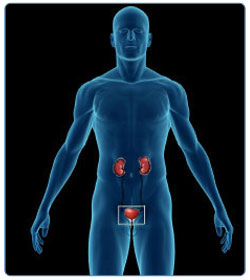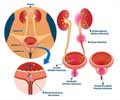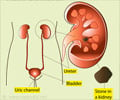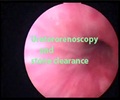- Cystoscopy - (https://en.wikipedia.org/wiki/cystoscopy)
- Cistoscopia - (http://www.mayoclinic.org/tests-procedures/cystoscopy/basics/definition/prc-20013535)
- What is Cystoscopy? - (http://www.urologyhealth.org/urologic-conditions/cystoscopy)
- About Cystoscopy - (https://medlineplus.gov/ency/article/003903.htm)
- Cystoscopy & Ureteroscopy - (https://www.niddk.nih.gov/health-information/health-topics/diagnostic-tests/cystoscopy-ureteroscopy/pages/default.aspx)
What is Cystoscopy?
Cystoscopy refers to the process of viewing a person’s urinary passage and bladder through an instrument introduced through their urinary passage. The instrument which is used for this purpose is called a cystoscope.
Cystoscopy is an endoscopic procedure i.e. there is no need for cutting or removal of any tissue. It is not an open surgery; so no scars are left behind on your body.
What is a Cystoscope?
The cystoscope is provided with lenses which allow the doctor to see the inner surface of the urethra (the tube which carries the urine from inside the body to the outside) and the urinary bladder (the organ which is used to store the urine). The cystoscope is as thick as a pencil and it has an opening at the end of the tube for the light.
A cystoscope may be rigid or flexible. A flexible cystoscope has flexible fiber optics which are used to transmit light from one end of the tube to the other. A cystoscope also has channels through which other small instruments can be introduced and used for specific purposes, for e.g. taking a biopsy.
A flexible cystoscope is carried out with regional or General Anesthesia and sometimes local anesthesia.
What is the Purpose of a Cystoscopy?
When you have a urinary problem, your doctor may ask you to get a cystoscopy done to rule out abnormalities in the bladder or urethra. It can be done with local anesthesia with minimal discomfort or it may be done using other forms of anesthesia.
The following conditions may require a cystoscopy to be done:
- Repeated attacks of urinary tract infection.
- The presence of blood in the urine (hematuria).
- Involuntary leakage of urine from the urethra (incontinence).
- Any abnormalities in passing urine - either in starting and / or completing urination, urgency in urination or not being able to empty the bladder fully.
- Painful urination not responding to conservative management.
- Blockage of urine due to enlargement of the prostate or narrowing of the urethra.
- Stones in the urethra or the urinary bladder.
- Any unusual growth in the urinary tract seen radiologically.

How Do You Prepare for Cystoscopy Procedure?
- The nurse or technician who is responsible for taking care of the patient in the ward will carry out certain instructions like cleaning the area around the urethral opening, administrating a local anesthetic if it is a flexible procedure and giving other test injections.
- The patient might be given specific instructions about:
- When and whether to drink plenty of fluids before the procedure.
- When to stop oral food intake before the surgery.
- Whether to give a urine sample before the procedure.
- As any medical procedure, whether minor or major has some amount of risk associated with it, the patient may have to sign a consent form expressing their consent for the surgery. They should not hesitate to ask their doctor about any doubts or fear they have about the surgery. They will be made to wear a hospital gown before getting shifted to the operation theatre.
- Once shifted to the operation theatre complex, the urologist will require information about their medical history, current pills being consumed and if they have any allergies to any medications.
- Finally, the anesthesia doctor will do a check to see if they are fit for surgery and shift them inside the operating room.
What is the Procedure of Cystoscopy?
- A cystoscopy can be done in a doctor’s office, in an outpatient clinic or in the hospital.
- A local or general anesthesia is given depending on the requirement of the situation. A local anesthesia is either an anesthetic gel around the urethral opening or an injection into the urethra. A general anesthetic is given intravenously.
- Women will be made to lie on their back with their knees raised and apart while men can lie down or be sitting.
- The lower part of the body will be covered by clean towels. Before this, a nurse or the doctor will clean your private area with an anti-septic solution.
- The doctor will gently pass the cystoscope through the urinary passage. Pelvic muscles must be relaxed to make this part of the test easier. A sterile solution (usually normal saline) will flow through the instrument to help the doctor have a better view of the urinary passage.
- As the bladder gets filled, there will be some discomfort and urge to pass urine.
- The linings of the urethra and the bladder are examined for abnormalities such as inflammation or a cancerous growth. In certain cases, the doctor might find something unusual like a stone or a growth in the urinary tract. In such a case, the procedure might get prolonged as the doctor will remove the stone or take a sample of the tissue for biopsy as the case may be. But in most of the cases, the entire examination will take about 15–20 minutes.
- In some cases, the doctor may also decide to place a tube or a catheter to drain the urine from the urinary bladder for 1 or 2 days.
What Happens after the Cystoscopy?
- Urine can be passed if needed. Temperature, blood pressure and pulse may be monitored regularly for a few hours (15 to 30 minutes).
- Any burning sensation while passing urine or blood in the urine can occur after an instrument has been put into the urinary passage. It will automatically settle within 1 or 2 days after the procedure if plenty of fluids are taken ( 2 to 3.5 liters/ day, two glasses every 2–3 hours).
- A warm bath or a damp washcloth over the urethral opening will relieve any discomfort while urinating.
- Antibiotics might be given for a few days following the procedure to prevent infection.
- Recovery depends on whether local or general anesthesia was given. Patients with general anesthesia will be discharged after 1 to 4 hours. Instructions will be given on rest, driving and physical activities.
- In most of the cases, normal food and normal activities can resume after cystoscopy. In some cases, you might have to be admitted for a day for observation. If such is the case, you will be discharged on the next day if your doctor feels so.
- A follow-up evaluation might be done that includes repeat urinalysis and a study that will evaluate the volume, speed and duration of urine released by the body.
What do Normal and Abnormal Results Mean in Cystoscopy?
Results might be discussed immediately or in a follow-up appointment. Any biopsies taken will be sent to the lab and results will be known later.
If the bladder has smooth walls, is of normal size, shape and position there is no cause for alarm. No blockages, growths or stones also indicate normal results.
Any signs that do not look normal could indicate bladder stones or cancer, bladder wall decompression, inflammation of the urethra, presence of polyps or cysts, irritable bladder, prostrate problems or a congenital abnormality.
What are the Complications of Cystoscopy?
- Urinary tract infections
- Blood in the urine
- Injury to Urethra.














